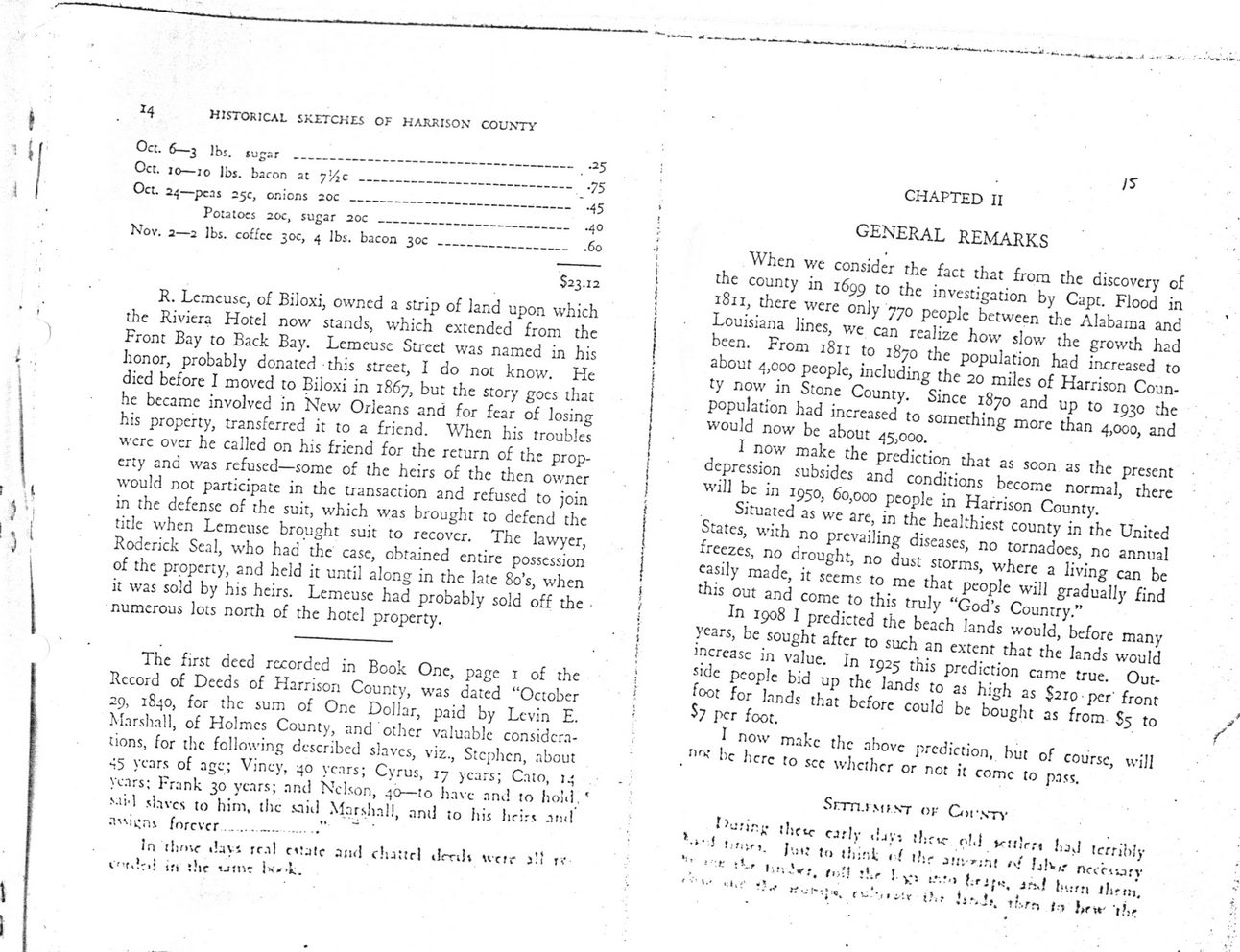This text was obtained via automated optical character recognition.
It has not been edited and may therefore contain several errors.
HISTORICAL SKETCHES OF HARRISON COUNTY Oct. 6—3 lbs. jugsr _____________________________________________ .25 Oct. 10—10 lbs. bacon at 7V2C ------------------------------- -75 Oct. 24—peas 25c, onions 20c ------------------------------------- .45 Potatoes 20c, sugar 20c ------------------------------- .40 Nov. 2—2 lbs. coffec 30c, 4 lbs. bacon 30c ---------------------- .60 $23.12 R. Lemeuse, of Biloxi, owned a strip of land upon which the Riviera Hotel now stands, which extended from the Front Bay to Back Bay. Lemeuse Street was named in his honor, probably donated this street, I do not know. He died before I moved to Biloxi in 1867, but the story goes that he became involved in New Orleans and for fear of losing his property, transferred it to a friend. When his troubles were over he called on his friend for the return of the property and was refused—some of the heirs of the then owner would not participate in the transaction and refused to join in the defense of the suit, which was brought to defend the title when Lemeuse brought suit to recover. The lawyer, Roderick Seal, who had the case, obtained entire possession of the property, and held it until along in the late So’s, when it was sold by his heirs. Lemeuse had probably sold off the numerous lots north of the hotel property. The first deed recorded in Book One, page 1 of the Record of Deeds of Harrison County, was dated “October 29, 1840, for the sum of One Dollar, paid by Levin E. Marshall, of Holmes County, and other valuable considerations, for the following described slaves, viz., Stephen, about 45 years of age; Vincy, 40 years; Cyrus, 17 years; Cato, 14 years; Frank 30 years; nntl Nelson, 40—to have and to hold . ’ Mi-1 staves to him, the said Marsha!!, and to !iis heirs Jn<! assigns* forever__________________” In dime i!ayi ten! esiate and c!u:trl droh uctr j!' K ift the I**1*.. IS CHAPTED II GENERAL REMARKS When we consider the fact that from the discovery of the county in 1699 to the investigation by Capt. Flood in 1811, there were only 770 people between die Alabama and Louisiana lines, we can realize how slow the growth had been. From 1811 to 1870 the population had increased to about 4,000 people, including the 20 miles of Harrison County now in Stone County. Since 1870 and up to 1930 the population had increased to something more than 4,000, and would now be about 45,000. I now make the prediction that as soon as the present depression subsides and conditions become normal, there will be in 1950, 60,000 people in Harrison County. Situated as we are, in the healthiest county in the United States, with no prevailing diseases, no tornadoes, no annual freezes, no drought, no dust storms, where a living can be easily made, it seems to me that people will gradually find this out and come to this truly “God’s Country.” In 1908 I predicted the beach lands would, before many years, be sought after to such an extent that the lands would increase in value. In 1925 this prediction came true. Outside people bid up the lands to as high as $210 per' front foot for lands that before could be bought as from $5 to $7 per foot. I now make the above prediction, but of coursc, will r>r*f be here to see whether or not it come to pass.

Hancock County 1 Historical-Sketches-of-Harrison-County-(032)